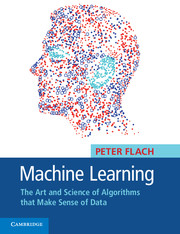Refine search
Actions for selected content:
2327 results in Pattern Recognition and Machine Learning

An Introduction to Support Vector Machines and Other Kernel-based Learning Methods
-
- Published online:
- 05 March 2013
- Print publication:
- 23 March 2000

Machine Learning
- The Art and Science of Algorithms that Make Sense of Data
-
- Published online:
- 05 November 2012
- Print publication:
- 20 September 2012
Index
-
- Book:
- Machine Learning
- Published online:
- 05 November 2012
- Print publication:
- 20 September 2012, pp 383-396
-
- Chapter
- Export citation
Epilogue: Where to go from here
-
- Book:
- Machine Learning
- Published online:
- 05 November 2012
- Print publication:
- 20 September 2012, pp 360-362
-
- Chapter
- Export citation
11 - Model ensembles
-
- Book:
- Machine Learning
- Published online:
- 05 November 2012
- Print publication:
- 20 September 2012, pp 330-342
-
- Chapter
- Export citation
7 - Linear models
-
- Book:
- Machine Learning
- Published online:
- 05 November 2012
- Print publication:
- 20 September 2012, pp 194-230
-
- Chapter
- Export citation
10 - Features
-
- Book:
- Machine Learning
- Published online:
- 05 November 2012
- Print publication:
- 20 September 2012, pp 298-329
-
- Chapter
- Export citation
Frontmatter
-
- Book:
- Machine Learning
- Published online:
- 05 November 2012
- Print publication:
- 20 September 2012, pp i-vi
-
- Chapter
- Export citation
5 - Tree models
-
- Book:
- Machine Learning
- Published online:
- 05 November 2012
- Print publication:
- 20 September 2012, pp 129-156
-
- Chapter
- Export citation
3 - Beyond binary classification
-
- Book:
- Machine Learning
- Published online:
- 05 November 2012
- Print publication:
- 20 September 2012, pp 81-103
-
- Chapter
- Export citation
2 - Binary classification and related tasks
-
- Book:
- Machine Learning
- Published online:
- 05 November 2012
- Print publication:
- 20 September 2012, pp 49-80
-
- Chapter
- Export citation
12 - Machine learning experiments
-
- Book:
- Machine Learning
- Published online:
- 05 November 2012
- Print publication:
- 20 September 2012, pp 343-359
-
- Chapter
- Export citation
Prologue: A machine learning sampler
-
- Book:
- Machine Learning
- Published online:
- 05 November 2012
- Print publication:
- 20 September 2012, pp 1-12
-
- Chapter
- Export citation
Contents
-
- Book:
- Machine Learning
- Published online:
- 05 November 2012
- Print publication:
- 20 September 2012, pp vii-xiv
-
- Chapter
- Export citation
6 - Rule models
-
- Book:
- Machine Learning
- Published online:
- 05 November 2012
- Print publication:
- 20 September 2012, pp 157-193
-
- Chapter
- Export citation
9 - Probabilistic models
-
- Book:
- Machine Learning
- Published online:
- 05 November 2012
- Print publication:
- 20 September 2012, pp 262-297
-
- Chapter
- Export citation
Important points to remember
-
- Book:
- Machine Learning
- Published online:
- 05 November 2012
- Print publication:
- 20 September 2012, pp 363-366
-
- Chapter
- Export citation
Preface
-
- Book:
- Machine Learning
- Published online:
- 05 November 2012
- Print publication:
- 20 September 2012, pp xv-xviii
-
- Chapter
- Export citation
References
-
- Book:
- Machine Learning
- Published online:
- 05 November 2012
- Print publication:
- 20 September 2012, pp 367-382
-
- Chapter
- Export citation
8 - Distance-based models
-
- Book:
- Machine Learning
- Published online:
- 05 November 2012
- Print publication:
- 20 September 2012, pp 231-261
-
- Chapter
- Export citation
